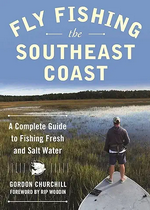There are many explanations about why tailing loops form and create “wind” knots. Lefty Kreh, as usual, goes to the heart of the matter. He says there are numerous “incorrect” explanations:
-Shocking the rod on the forward or backward cast;
-Beginning the forward cast too soon;
-Beginning the forward cast too late;
-Overpowering the rod on the forward cast.
While all of those are examples of bad form and cause numerous casting problems, the real reason we have tailing loops that develop small wind knots that will cause our leader or tippet to break when a big fish hits is something else.
Lefty says the real reason is that we don’t dip the tip of the rod on the STOP at the end of the forward cast. When the rod tip travels in a straight line, meaning the rod tip stays in the same plane, unless we dip the rod tip down at the very end, the line will run into it, creating a tailing loop and likely a “wind” knot.
Having said that, he also notes that if we raise our elbow (and thus our arm) during the cast, the rod tip will travel in a U shape, placing the top of the loop with the leader and fly following it below the rest of the line, causing a tailing loop. And if we stop the rod tip on the forward cast too high, without dipping it down, a tailing loop will occur.
So,
-Keep the rod tip in the same plane by not breaking your wrist on the backward cast;
-Do not start the back cast with the rod tip too high off the water- there will be too much slack in the line and you will wind up breaking your wrist and having a very wide loop;
-Make sure you let the line straighten out on the back cast;
-If it hurts, you are doing it wrong;
-Keep the elbow on the shelf and never let it (and your forearm) rise;
-Always keep your elbow “inside” your hand- except on very long casts when you must extend your forearm and your upper arm behind you to make sure you have enough distance to accelerate your line for the forward cast- but even then, try to avoid breaking your wrist or moving your elbow “outside” your wrist. [The rules of physics suggest that in a perfect world, a fly dropped will hit the water at the same time a fly cast straight out will hit the water. In other words, you don’t have extra time to have the fly travel a long distance. It will only travel a long distance if the fly line is traveling faster. This is accomplished by use of the double haul and taking your rod tip further back on the back cast while maintaining the tip in the same plane. This gives you more distance to accelerate the line in the forward cast. This, along with a well-timed double haul, will give you the line speed you need for a longer cast. Just don’t stop the rod tip too high without dipping it down slightly to get it out of the way of the loop, leader, and fly. Failure to dip the rod tip will lead to a tailing loop and may create a wind knot, which Lefty says is a “poor casting knot.”]
Don’t forget to check out the resources of Fly Fishers International at www.flyfishersinternational.org.
Also, Google this and other topics of interest and go to YouTube for seemingly endless videos.



